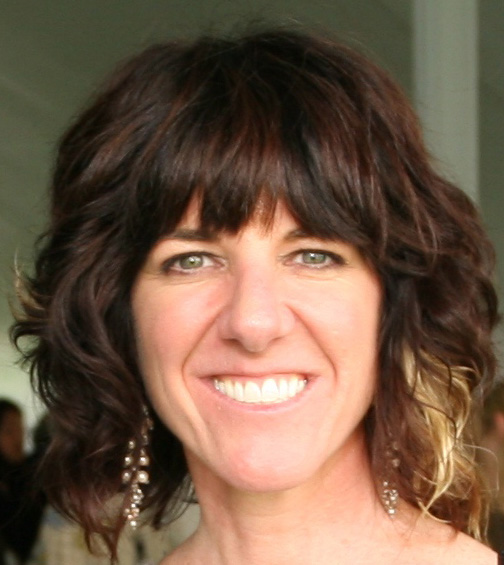Educating the Head and the Heart: A Guest Blog by Tannis Deloyola
October 28, 2014

This week we introduce the first of our invited guest blogs. In this blog, Tannis Deloyola, a 9th grade English teacher at Canyon High School in Anaheim, California, shares her thoughts about the Holocaust Art and Writing Contest and its impact on her students. A dedicated educator, Tannis has participated in the contest since 2007.
Standing and watching from across a table in the excited atmosphere of the venue, I was captured by the beauty of the encounter that was developing in front of me. It was humble, profound and arresting. In a long line of incredible occasions I have witnessed as an educator, it was the most sublime. These remarkable occasions usually occur in the classroom; however, in that moment I was not teaching: I was far from my school, far from my classroom, far from poetry, literary terms, thesis statements, and critical analysis.
I even felt far from Earth as I stood transfixed watching my student, 9th grader, Kamryn Sanchez speak gently and quietly with Holocaust survivor, Esther Stern. In a room filled with Holocaust Survivors and eager students, the two leaned close to one another deep in conversation. An 80+ year old and a 15 year old: connected by Ester’s testimony of her experiences and Kamryn’s response, a powerful, exquisite poem that spoke of the brutality of inhumanity and of Ester’s disbelief that humanity could possibly exist anywhere in a world of concentration camps and death marches. As the two spoke, Kamryn cried. Kamryn’s mom cried. And I –unable to hear a word spoken between them – cried along with them.
This poignant connection between a 9th grade student and a Holocaust survivor came about because of a special learning opportunity which challenges students to connect through art, writing or film with men and women who experienced humanity at its worse, who experienced silence from the world, and who experienced inexplicable loss and suffering. This opportunity goes far beyond a history textbook or even a literary memoir. It exists because people believe that living history and the preservation of memory are important, indeed crucial. It exists because of the Chapman University Holocaust Art and Writing Contest.
Through the Holocaust Art and Writing Contest students like Kamryn develop a personal relationship with the past, a relationship that is interactive and reflective. They create their own beauty from memories filled with loss and pain. And with their art, writing, or film, they reaffirm and reestablish the life of the person who has shared the memory, often a person no longer with us. They prove that with our resolve those who experienced the Holocaust still have a voice; they are still heard. And they will always be remembered.
The Holocaust Art and Writing Contest grants us, as educators, the occasion to develop a personal relationship with the past as well— one that shapes our classroom lessons and allows us to guide students through the history of the Holocaust with empathy and respect. Participating in the contest for the last nine years has influenced me to strive to be a better guide – to support students as they engage this difficult history and strive to make meaning of it. It has inspired me to create opportunities for all students and staff at Canyon High School to commemorate and honor the 1.5 million children who perished during the Holocaust. My relationship with these events of the past is one that is current. It is ever-evolving. It is painful. It is motivational. It is trying. It is valuable. It is lasting. And, with this bond I am continually blessed with extraordinary rewards – rewards which are substantial and unquantifiable.
In addition to witnessing the beautiful connection between Esther and Kamryn, and being inspired to advance my effectiveness a teacher, participating in the Holocaust Art and Writing Contest has also afforded me incredible opportunities which still seem absolutely unreal to me. I have been in the presence of Holocaust survivors on many occasions (I get nervous each time); I have been able to bring a bus of 9th graders with me to meet and interact with Holocaust survivors. I have spoken with Professor Elie Wiesel during three separate educator seminars (he is one of my heroes); I have been gifted with Holocaust literature, and with books of poetry and art written by the children of the Terezin Concentration Camp; I have received the extraordinary resource of donated Holocaust literature for our school library. Each of these gifts has helped me grow as an educator, as a mother, and as a person. And for each of the gifts I feel truly grateful.
None of these astonishing opportunities would have been possible had it not been for people who believe that memories deserve to be honored and who believe that keeping the past alive is imperative. People, to whom, I am forever indebted. I am especially thankful to Chapman University, to the Rodgers Center for Holocaust education and to Marilyn Harran and staff. And, I would like to give a very special thank you and ‘shout out’ to Jessica MyLymuk for nudging me into participating in the contest nine years ago, for providing unwavering support as friend and mentor over the last nine years, and for her unfailing dedication, encouragement, understanding and support to the teachers and students who participate in this contest each year. I am so very excited to be beginning this journey with my students once again. I know it will demand much from us as teacher and students–and I know it will give us even more in return.
